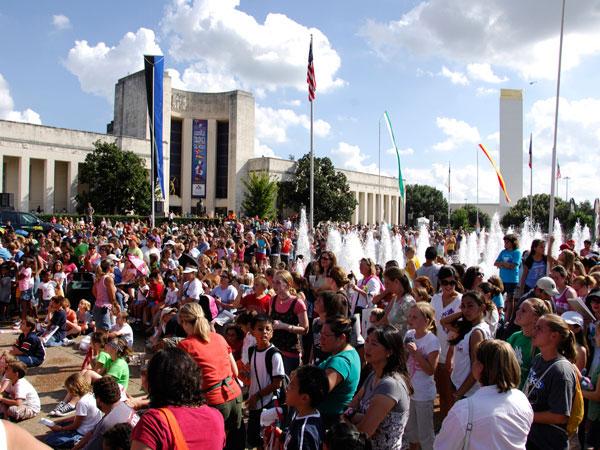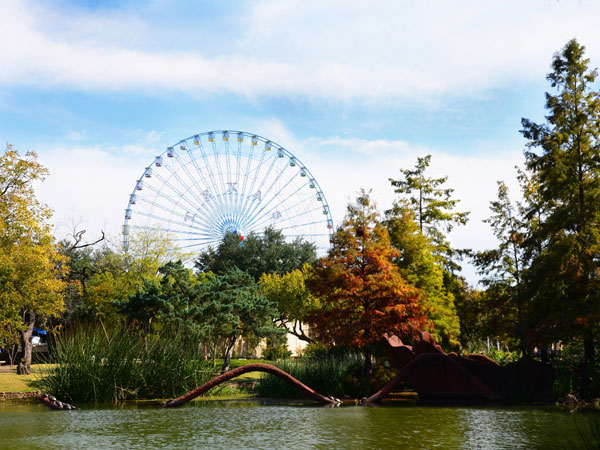Fair Park: Dallas, Texas
>
Summary
Fair Park combines City Beautiful Movement planning influences with the country's largest collection of 1930s Art Deco architecture. "A wonderful place to spend a Saturday afternoon exploring ... art and architecture," says Eddie Hueston, former Fair Park executive general manager. For more than a century the park, two miles east of downtown Dallas, has been delighting millions of visitors. Attractions on its 277 acres include eight museums, six performance facilities, and a major sports stadium.
Designated Area
Fair Park is located at 3809 Grand Avenue.

Fair Park features a reflecting pool synced to lighting and music, the largest collection of unaltered 1930s Art Deco exposition architecture in the United States, four distinct ‘zones' within the park, and a superb view of the Dallas skyline. Photo courtesy of Quimby McCoy Architecture Firm.
Planning Excellence
Scores of activities and events occur here throughout the year, from the State Fair of Texas to the Cinco de Mayo celebration, North Texas Irish Festival, CityArts Festival, and Kwanzaafest.
Located on a former cotton field, the site was initially acquired by a group of civic leaders for an annual state fair, which began in 1886. Renowned landscape architect and city planner George Kessler was later hired by the city to re-plan the site and identify sites for future buildings. Influencing his 1906 plan and design was the City Beautiful Movement, which advocated city beautification through well-laid-out public spaces, tree-lined boulevards, monuments, public art, and fountains — all of which are found at Fair Park.
The other person who played a major role in the design of the park was architect George Dahl. He was responsible for transforming the fairgrounds into the 1936 Texas Centennial Exposition, which was designed and built in just over 14 months. The centerpiece of the exposition was the Art Deco-style Hall of State with three-dimensional bas-relief carvings. Leading up to this building is an esplanade with a 700-foot-long reflecting pool. Rebuilt in 2009, the pool now has lights and a sound system for synchronized water, music, and light displays.
To assist the City of Dallas in raising money to restore and find new uses for the park's buildings, the nonprofit Friends of Fair Park was organized in 1986. Since the early 1990s more than $260 million in park plans, renovations, and improvements, including development of a comprehensive park plan, have been made by Dallas and its private partners.
"Fair Park is much more than an assemblage of buildings," notes National Geographic's Traveler magazine. "[It's] a district telling dozens of stories from dozens of cultures."

A crowd gathers for the annual Texas State Fair in front of the Hall of State building. This plaza is used to host many events that take place on the park grounds throughout the year. Photo courtesy of the State Fair of Texas.
Defining Characteristics, Features
History
- Dallas State Fair and Exposition Board of Directors purchases 80 acres for use as the annual Texas State Fair (1886)
- George Kessler's 1906 work, the first formal plan for the park, incorporates buildings within site boundaries; draws on thinking of City Beautiful advocates, including the famous Chicago planner Daniel Burnham
- Dallas selected among competing Texas cities as site of the 1936 Texas Centennial Exposition, one of six world's fairs staged in the U.S. during the 1930s; Greater Texas and Pan American Exposition held at park in 1937
- Park named a National Historic Landmark (1986)
- Hargreaves Associates produces 2003 Fair Park Comprehensive Development Plan; includes recommendations for physical site, park programs, activities, sources of funding, and management alternatives
- City bond issue (2006) includes $72 million for park repairs and improvements
Design, features
- Architect George Dahl directs Dallas architects to design, build 26 major buildings in just over 14 months; $1.3 million State of Texas Building (Hall of State) most expensive structure per square foot ever built in Texas at the time
- Other buildings and structures at the park include Dallas Museum of Nature and Science, Dallas Children's Aquarium, Texas Discovery Gardens, Texas Museum of Automotive History, Women's Museum, African American Museum; park has North America's tallest Ferris wheel
- Artists commissioned by Dahl include Lawrence Tenney Stevens, who created sculptures — representing the Confederacy, Spain, and Texas — in front of Centennial building; Raoul Josett designed sculptures outside Automobile Building that represent Mexico, France, and U.S.; Carlo Ciampaglia designed monumental murals on many exhibit halls
- Esplanade is located just inside the Parry Avenue entrance; provides symmetrical processional space with buildings, art, reflecting pool
- Other major areas of park are the Agrarian District, which includes a narrow street with buildings on either side; the organic and natural Lagoon; the Midway is a long spine extending through park and accommodating amusement attractions
- Park has street network; site of 92,000-seat Cotton Bowl football stadium
- Easily accessible from two DART light rail stops (Parry Avenue gate, Martin Luther King Boulevard), cars, bicycles, walking
Community participation, honors, economic impact
- Groups and agencies supporting park include Dallas Park and Recreation Department, Friends of Fair Park, Dallas Planning Department, Dallas Landmark Commission, Preservation Dallas, Texas Historical Commission
- Since 2000 park has received more than 25 honors and awards
- Park events contribute more than $300 million annually to the Dallas economy

The natural setting of the lagoon is a refuge from the buildings and landscaped sections of the park. The iconic Texas Star Ferris Wheel, the largest in North America, can be seen from almost anywhere in the park. Photo courtesy of the Dallas Park and Recreation Department.


